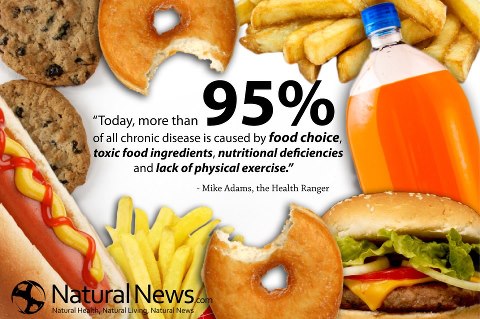
Additives. Dyes. Chemicals. Hormones. If you’re eating anything that comes in a package, you’re consuming them. How many ingredients in the foods you eat on a daily basis can you not even pronounce, let alone know what they are doing to your body?
Sixty-five years ago, everyone knew where his or her food came from: the local farms or the backyard. If you went back in time and ventured into a grocery store in 1950, 95% of the things you see on today’s shelves would not exist. Now that manufactured “food” is a part of life, additives like partially hydrogenated oils, MSG, corn syrup and transglutiminase (a meat glue that transforms itty bitty pieces of meat into larger cuts) sneak their way into our daily intake without us giving it a second thought.
Here are just a few of those additives commonly found in our food supply:
Azodicarbonamide: sounds tasty right? It’s a bleaching agent used in white flour, bread and rolls. I don’t know about you, but I don’t ever want to eat bleach.
Yellow 5: the second most-used food dye often found in candy, baked goods and pet food. It has been linked to hyperactivity in children and causes allergy-like symptoms especially for those that are aspirin-sensitive.
Diacetyl: a yellow/green liquid chemical with an intensely buttery flavor that makes popcorn, margarine and butter-flavored cooking oils taste, well… buttery. After being exposed to high levels of diacetyl, young, non-smoking, otherwise-healthy microwave popcorn factory workers were developing obstructive lung disease. Amidst several lawsuits, many manufacturers have removed or reduced the amounts of diacetyl in their products, but it’s still a legal food additive despite the well-documented dangers. Thanks FDA.
There are hundreds of additives that are “recognized as safe” to use in our food supply, but if you actually knew what they were you probably wouldn’t want to consume them.
Why do food manufacturers add these things to our food supply in the first place? Because they can. You would think that our government agency responsible for making sure our food supply is safe (the FDA) would be the ones doing the testing of these food additives, right? But no, it’s the food manufacturers that do the testing. It is in their best interest to produce food that can sit on the shelves for a long period of time without spoiling in the cheapest way possible. It’s a self-policing system that works for them, but not for us.
What can you do?
Rely primarily on whole foods. No, not the grocery store. A whole food is a food that has been processed or refined as little as possible and is free from additives or other artificial substances. Whole foods may be organic, locally grown, or pesticide-free, but not necessarily. A whole food is simply a food in its natural state, with all of its nutrients and health benefits intact. The opposite of whole foods are highly processed foods (most things in boxes and bags in the grocery store).
If you pick up a box and it has an entire paragraph of ingredients and it takes you more than 30 seconds to skim through, put it back. If you can’t pronounce more than a few ingredients, put it back. If your brain doesn’t recognize an ingredient as food, neither will your body.
That doesn’t mean you need to eat only 100% pure and organic foods with no added sugars or preservatives 100% of the time. The goal is just to decrease the number of processed foods you eat and increase the proportion of healthy whole foods.
Decide for yourself. The Center for Science in the Public Interest has a great website that breaks down hundreds of additives, explains where and why they’re used and gives them a grade that ranges from Safe, Cut Back, Avoid and Caution.
Download CSPI’s app, Chemical Cuisine, which allows you to look up unfamiliar food ingredients as you come across them right on your smartphone. Once you know what the additive is and what it’s used for then YOU can decide if you are OK with consuming it.
At the risk of sounding like a Captain Planet or Smokey the Bear commercial, only you have the power to decide what you put in your body. Don’t let food manufacturers make that decision for you.

